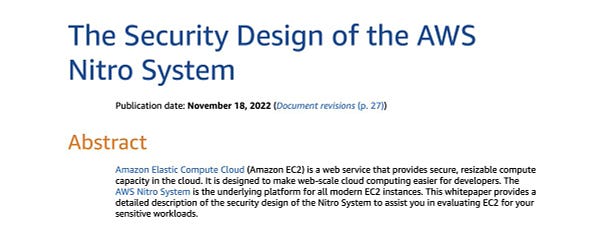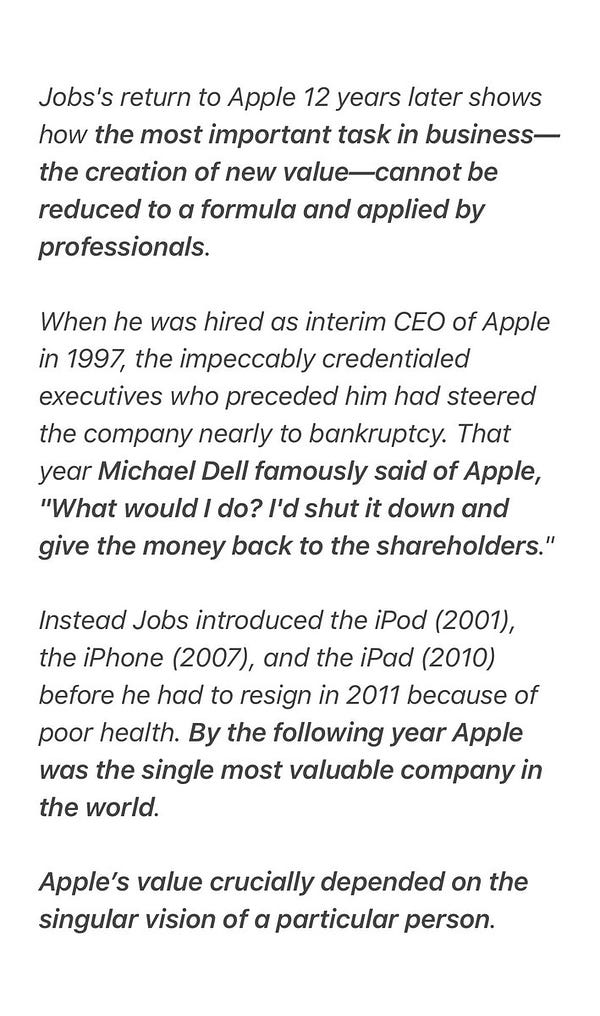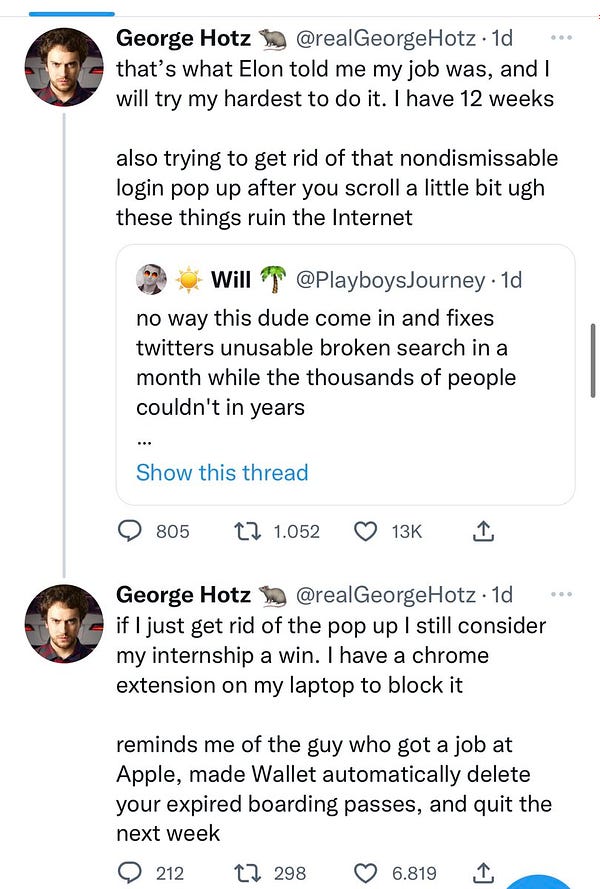

Discover more from What's Hot 🔥 in Enterprise IT/VC
What's 🔥 in Enterprise IT/VC #317
Navigating your first enterprise sales in 2023 - innovative is great, but save me 💰 or give me a 2:1
It’s Thanksgiving week 🦃 in the United States, and it’s a great time to take a pause and reflect on the year that has passed and think about all that you are grateful for 🙏🏼.
It’s also the week before AWS re:Invent which is back in full force, and a time to 🙏🏼 that your startup does not get killed with the launch of a new AWS service. We’ll be passing on this year’s event after 5 years of participating. While it’s an awesome place to get together with many of our startup founders and friends in the venture community, it simply has gotten too big.
During the last couple of weeks, I’ve had several conversations with IT buyers at large organizations to get a feel and understanding for what’s top of mind for them heading into 2023. Besides digging into cloud costs, this quote below sums up the environment for startups and IT Spend:
Last year in my budget, I could easily find a small pocket of💰 for innovation here and there. This year I can’t just buy innovative - it has to be innovative and save me money and ideally be a 2 for 1 or show me a quick path for 2 for 1.
If you’re a startup selling into this environment, how do you compete and win especially if you just do one thing well?
Have a killer product with instant time to value and limited operating overhead. Those are table stakes and hits the “save me money” comment above.
Sell the product, market the vision (read What’s 🔥 #212 for more): Perhaps you have a solution which is 10x better than what is already there, but you can’t do a 2 for 1 on the product side today. Get the user/buyer/customer 🔥 up about what you have today, but also show your roadmap over the next several quarters to show how you can get there. Make this process interactive, get feedback from the customer, make them part of the process, and build the trust.
Show incredible ROI for current product - good enough when it comes to limited new vendors slots doesn’t work - show the value whether it’s in reducing operating costs and the number of people needed to solve an existing problem or increased productivity - and if you can, create a ROI calculator - can be hokey but something that a user can share with their boss - take a look at the Hubspot Saleshub calculator.
Make it easy for the user to get budget approval: arm your user, particularly if a land and expand model, with a one pager for the boss to explain the benefits and even better if showing data from a production environment for example like vulnerabilities found and fixed or APIs secured or whatever shows value to help your users get budget $$$.
Land and expand: small lands always work to get under initial budget numbers with a goal to get the customer addicted to your product for expansion in better times. Small lands also help avoid the problem of getting multiple approvals and signatures to close a deal. This is also a great opportunity in 2023 for those with cash to go after new logos with an eye on expanding in 2024.
Innovative pricing: Depending on the vendor the customer is trying to replace, offer to price your product for the maintenance for the current software or give it away free until the current SaaS contract is up for renewal - this works great when 6 months or less left in contract. Kustomer did this well in the early days as it replaced Zendesk and Salesforce.
In the midst of IT Spend questions and a impending recession, many a VC during due diligence for Series A and B rounds will want to talk to live customers about all of the above. Make sure you don’t leave this to chance! Call each and every customer you plan to have as a reference and make sure they hit the main points - can’t live without this product, makes my team XX more productive and saves $XX, buy into vision and long term roadmap, builds fast, trusted relationship…Also make sure to properly gate these conversations and that the investor is truly excited and up to speed on the product and will ask the right questions. The worst thing you can do is burden your customer with too many VC calls and inundate them with conversations that go nowhere.
As always, 🙏🏼 for reading and please share with your friends and colleagues!
Scaling Startups
End of an era - well said, what I call founders who are more 🥩 than sizzle 🥓 (read more from What’s 🔥 #296 July 16)
💯
Same goes for all startups pre-product market fit
Along those lines…
Enterprise Tech
Hot take on future of software development and generative AI 🧵
 I don't think people understand the monumental changes coming to software this decade. Quick thread:
I don't think people understand the monumental changes coming to software this decade. Quick thread:More on AI assisted development
 Doing a code review right now - saw some code I did not immediately follow, so instead of mentally running the code line-by-line like I normally would, I pasted into GPT-3 and asked questions. GPT-3 explained the code to me - correctly. 🤯
Doing a code review right now - saw some code I did not immediately follow, so instead of mentally running the code line-by-line like I normally would, I pasted into GPT-3 and asked questions. GPT-3 explained the code to me - correctly. 🤯And 😲 what’s coming next after GitHub Copilot - AI powered pull requests!
What’s next in cloud security? Wiz, the fastest growing CNAPP (cloud native application protection platform), is now the first CNAPP co to launch its own DSPM (data security posture management). Let the game of musical chairs begin as Palo Alto Prisma and others respond - also congrats to BigID who is a Wiz partner…
One such customer is Chevron Phillips Chemical Company, which uses Wiz to discover and protect mission-critical data. For Cory Zaner, Cloud Security Manager, "We are not the data governance team, but we want to proactively protect our data in the cloud. The visibility that Wiz gives us into our data and how it maps to external exposure is key as we don't want to be in the news." Asonye Onwudebe, Cloud Security Architect, explains further, "Wiz is our early warning system for critical data risks. Wiz alerts us with laser precision and all the context needed to take fast proactive action to prevent issues from becoming data breaches."
Integration with data security technologies: Wiz integrates with third party services like BigID and native tools like Amazon Macie to provide even more data context for risk prioritization and decision-making.
Recap on what’s 🔥 from Kubecon from Daniel Bryant Ambassador Labs (a bit late as just found it via Gareth in his DevOps Weekly)
So, what did we learn from KubeCon NA 2022? These are my top 10 takeaways:
Building for the road ahead: The importance of community and maintainers
The future is built on open standards
Developer experience is now table stakes
Developers are struggling with fast feedback
DevOps is not dead… but platform engineering sure is popular
The search for platform orchestration (and abstraction)
Wasm appears to be the next hottest runtime
Hot tech: eBPF and secure supply chain/SBOMs
Mo’ Money, Mo’ Problems: Observability, security, and AIOps
Lift, shift, and modernize: Legacy tech is so last year
Worth reading - this is huge and makes secure enclaves of data and ability to process that data cheap and scalable - also check out Cape Privacy (a port co) which empowers developers to build secure applications which protect the underlying data and code from the cloud.
AWS Nitro Enclaves is a new EC2 capability that enables customers to create isolated compute environments (enclaves) to further protect and securely process highly sensitive data such as personally identifiable information (PII), healthcare, financial, and intellectual property data within their Amazon EC2 instances. Nitro Enclaves helps customers reduce the attack surface area for their most sensitive data processing applications.
 A new AWS whitepaper covering Nitro - "The Security Design of the AWS Nitro System". Super interesting deep dive into virtualization and the AWS approach to security. HTML: docs.aws.amazon.com/whitepapers/la… PDF: docs.aws.amazon.com/pdfs/whitepape…
A new AWS whitepaper covering Nitro - "The Security Design of the AWS Nitro System". Super interesting deep dive into virtualization and the AWS approach to security. HTML: docs.aws.amazon.com/whitepapers/la… PDF: docs.aws.amazon.com/pdfs/whitepape…
If you want the TLDR version, I’d watch this video from Colm on Youtube (4 mins)
On Twitter and software complexity
Markets
Great read on structural dynamics of auto industry and how Mercedes and others are playing catch up - will they become the next Nokia? This is also great example of the old school enterprises who will be buying dev tools, infra, data infra and security in the next 5 years. (The Economist)
Established carmakers are furiously recruiting chief software officers (csos), developing their own oss and holding “software days” to present digital strategy to investors. But most have yet to create an organisation capable of straddling hardware and software; to decide which pieces of software to keep firmly under their control and develop in-house and which to outsource; and to come up with a profitable business model for services made possible by all the code.
“Any co-operation has to be structured in such a way that we keep control of all the car’s data,” insists Frank Weber, who heads development at bmw. To temper the power of big tech, Mr Weber has long been calling for German carmakers to share costs by jointly developing software that does not differentiate them. So far the industry’s competitive instincts have prevailed. But an open-source project for software-defined vehicles within the Eclipse Foundation, an umbrella organisation for carmakers as well as tech firms for such initiatives, has recently gained momentum.
Subscribe to What's Hot 🔥 in Enterprise IT/VC
Ed Sim's (@boldstartvc) weekly readings and notes on enterprise VC, software, and scaling startups

















Thanks Emilio. And love that point - 1/2 to support or TCO is 1/2
Such a good article. I get so excited about new products that are 10x better. In my opinion, some of the big enterprises can absorb 2 for 1, but a good ROI I am seeing from these new disruptive products is that it takes 1/2 (at least) the people to support it internally.